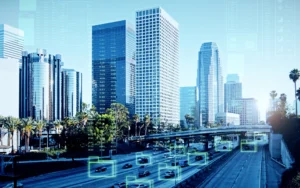Lessons from Smart Cities
Smart cities integrate digital tools across urban infrastructure, offering valuable lessons for public agencies:
- IoT Sensors for Real-Time Data: Cities use IoT to monitor traffic, air quality, and utilities. Public works can replicate this by tracking water usage, road conditions, or waste collection.
- Digital Citizen Engagement: Smart city apps allow residents to report issues, pay bills, or access services online. Public agencies can use similar platforms to reduce call center loads and improve responsiveness.
- Data-Driven Policy Making: By analyzing real-time data, smart cities make better decisions about resource allocation, mobility planning, and emergency response. Public agencies can apply these insights to infrastructure investments and maintenance.
Lessons from Airports
Airports operate in high-stakes environments where efficiency and safety are critical. Their digital transformation journey provides equally valuable insights:
- Predictive Maintenance: Runways, baggage systems, and fleets are monitored using predictive analytics, reducing costly failures. Public works agencies can apply the same logic to bridges, pipelines, and vehicles.
- Passenger-Centric Digital Tools: Airports use apps, kiosks, and AI assistants to guide travelers. Similarly, agencies can build user-friendly portals to help citizens access permits, request services, or track progress.
- Cloud Collaboration: Airports rely on cloud platforms to coordinate between airlines, regulators, and staff. Public agencies can use similar systems to break down silos between departments and improve decision-making speed.
The Cultural Shift Behind Digital Transformation
Technology alone isn’t enough. Both smart cities and airports show that successful digital transformation depends on:
- Leadership commitment: Executives who champion innovation and allocate resources effectively.
- Staff training: Empowering teams to use new tools confidently.
- Citizen and passenger focus: Prioritizing the needs of end users over internal convenience.
Public agencies must adopt this same mindset to ensure digital transformation is sustainable and impactful.

Conclusion
Smart cities and airports are proving that digital transformation is more than a buzzword—it’s a pathway to resilience, efficiency, and better service delivery. For public works agencies, the lessons are clear: embrace real-time data, adopt predictive tools, engage stakeholders digitally, and foster a culture of innovation.
By following these examples, public agencies can not only modernize but also build trust, reduce costs, and provide the high-quality services that citizens increasingly expect. The future of infrastructure and public service is digital—and the time to act is now.


